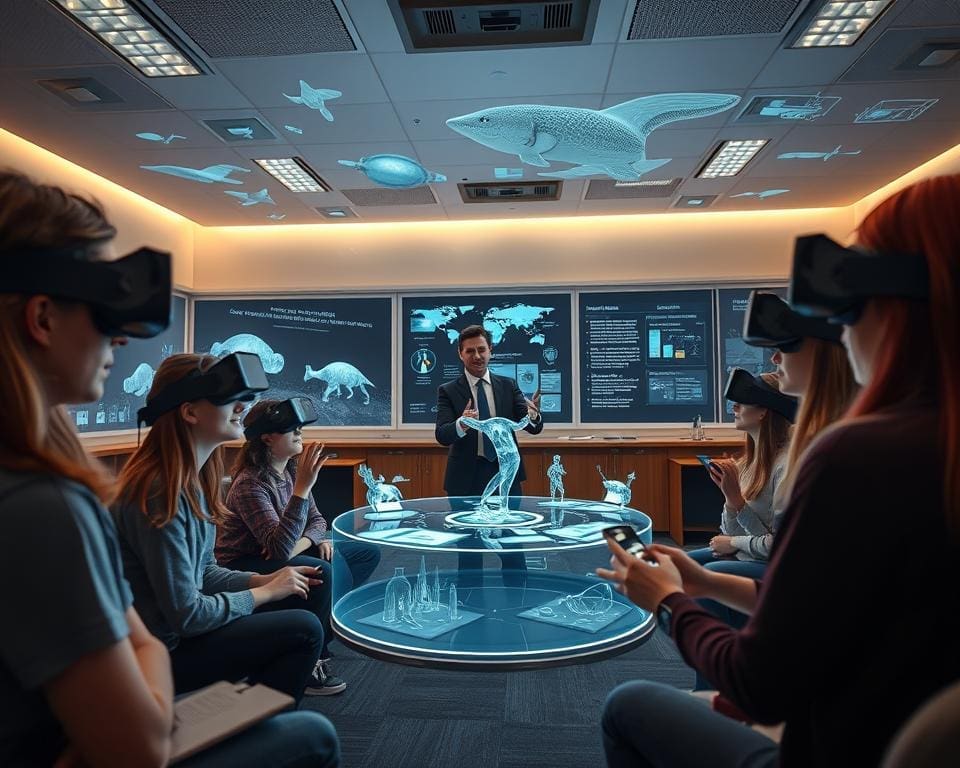As educational landscapes continually evolve, one question resonates profoundly: Is AR the future of education? Augmented reality in education is rapidly gaining traction, presenting immersive learning experiences that captivate students’ imaginations. As we witness significant interest in future trends in educational technology, it becomes increasingly clear how AR holds the potential to revolutionise traditional teaching methodologies. Current statistics indicate a remarkable growth in the adoption of AR tools, prompting educators to rethink how they engage students and enhance learning effectiveness. This article endeavours to explore the transformative impact of augmented reality across educational contexts, setting the stage for a deeper dive into its promising future.
The Rise of Augmented Reality in Education
As technology continues to advance, augmented reality in education has emerged as a powerful tool for enhancing learning experiences. By layering digital information over the physical world, AR creates immersive learning experiences with AR that capture students’ attention and foster engagement. Understanding how augmented reality functions sets the stage for exploring its transformative impact on educational practices.
Understanding Augmented Reality Technology
Augmented reality technology differs significantly from virtual reality, which aims to create a completely immersive digital environment. AR, on the other hand, enriches the real world with interactive elements, allowing learners to engage with content in innovative ways. This technology utilises devices such as smartphones, tablets, and specialised glasses to project interactive visuals that enhance comprehension and retention.
The Evolution of Educational Practices with AR
The integration of augmented reality in education has revolutionised teaching methodologies, leading to the development of new pedagogical strategies. Current trends in AR technology showcase how educators are moving beyond traditional approaches, creating interactive learning scenarios that encourage exploration and experimentation. Various educational institutions have embraced AR, evident in:
- Enhanced visual learning through 3D models, allowing students to explore complex concepts in science and mathematics.
- Interactive applications that promote collaborative learning experiences among classmates.
- Real-time feedback mechanisms that tailor learning paths to individual needs.

Is AR the future of education?
The integration of augmented reality (AR) within education reflects the transformative potential of technology in the classroom. As educators explore innovative ways to engage students, emerging tools are paving the way for more interactive learning experiences. Understanding the current trends in AR technology reveals its significant role in reshaping educational practices and promoting student comprehension.
Current Trends in AR Technology and Education
Today, schools across the UK are increasingly adopting AR applications, creating engaging environments that enrich traditional teaching methods. Popular platforms, such as Google Expeditions and Merge Cube, allow students to interact with three-dimensional objects in real-time. The continuous development of AR technology benefits learning by enhancing visualisation and interactivity, catering to diverse learning styles.
Successful Case Studies of AR in Classrooms
Numerous case studies demonstrate the positive impact of augmented reality on academic performance. For instance, a secondary school in London implemented an AR-based science curriculum, which led to a 25% increase in students’ understanding of complex scientific concepts. Virtual reality in schools has also been shown to boost motivation and engagement levels. Students using AR applications reported higher satisfaction with their learning experiences, contributing to more effective retention of knowledge.
AR Technology Benefits in Learning
Augmented Reality (AR) has emerged as a transformative force in education, enriching the learning experience with its innovative features. The AR technology benefits in learning extend far beyond mere engagement; it fosters an atmosphere of enthusiasm and curiosity, making the educational process more inviting for students. Particularly for those who struggle with traditional approaches, interactive learning through AR offers a captivating alternative that can spark interest and motivate them to explore various subjects.
Enhanced Engagement and Motivation for Students
AR technology captivates students’ attention through immersive experiences that traditional teaching methods often lack. When students interact with digital images overlaid onto the real world, they are not just passive recipients of information. Instead, they actively participate in their own learning journeys. This interaction helps foster a sense of ownership and accountability in their education.
Improved Retention and Understanding of Complex Concepts
Psychological theories emphasise the role of visualisation in learning. When students employ AR, they can better grasp intricate ideas by visualising concepts in three dimensions. This method facilitates improved retention through AR, allowing learners to recall information more effectively. Studies illustrate that using AR can lead to higher comprehension levels in complex subjects, thus confirming its effectiveness in modern educational settings.
Implementing AR Applications in Classrooms
As educators increasingly explore AR applications in classrooms, a spectrum of innovative tools has emerged to facilitate immersive learning experiences with AR. These applications range from virtual field trips to interactive lessons that captivate students’ attention, enhancing both engagement and comprehension. Understanding the various types of AR tools available is essential for effective integration into existing curricula.
Types of AR Applications Used in Education
Numerous AR applications have been designed to elevate classroom experiences. Popular examples include:
- Google Expeditions: This tool allows students to embark on virtual reality field trips, exploring historical sites or natural wonders from their classroom.
- Aurasma: An application that enables users to create augmented reality experiences linked to real-world images, enhancing subjects like art and history.
- Merge Cube: A physical cube that, when viewed through a compatible device, unlocks various educational content, turning any surface into an interactive learning platform.
Challenges and Considerations for Teachers
Despite the potential of AR technology, challenges in AR technology implementation can pose hurdles for educators. Key considerations include:
- Training requirements for teachers to effectively utilise new technology, ensuring they are comfortable and competent in its application.
- Accessibility issues for students, particularly those with special educational needs, necessitating adaptations of resources to accommodate all learners.
- Potential resistance from both students and educators who may be sceptical about the value and efficacy of integrating AR into traditional teaching methodologies.
Future Trends in Educational Technology with AR
As we look toward the next era of educational development, the future trends in educational technology promise to be both exciting and transformative. Augmented reality (AR) is set to revolutionise the classroom experience, with gear becoming increasingly accessible for students. This evolution will likely lead to more immersive and interactive learning environments, where AR for interactive learning becomes a staple for educators keen to engage their pupils.
Adopting AR technology in education is not merely about visuals; it is also about reshaping pedagogical methods. The evolution of AR in education is poised to encourage educators to think beyond traditional teaching styles, fostering creativity and exploration in lesson delivery. The future will undoubtedly see an integration of AR with emerging technologies like artificial intelligence and machine learning, creating increasingly sophisticated learning experiences that adapt to the needs of each student.
In conclusion, as educators and institutions embrace these innovations, they will pave the way for AR to become a cornerstone of future educational frameworks. This shift will enhance learner engagement exponentially, empowering students to actively participate in their learning journeys. The synergy between AR and new technologies will create robust platforms for an educational experience that is not only informative but also spectacularly engaging.









